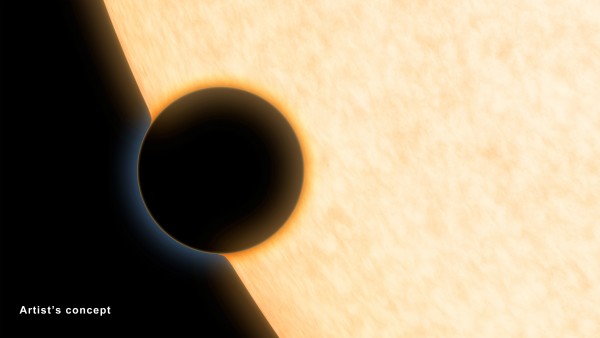NASA Telescopes Find Water on Exoplanet 122 Light Years Away
| Ana Verayo | | Sep 25, 2014 12:30 AM EDT |
(Photo : NASA/JPL-Caltech) Hat-P-11b is an exoplanet with water vapor in its atmosphere
Astronomers have finally discovered a potentially habitable planet after detecting water vapor on an exoplanet 122 light years from Earth.
Hat-P-11b is apparently a "small" planet but unlike others that possess a thick cloud blanket that precludes atmospheric analysis, this planet has uncannily clear weather that made water vapor measurements possible.
Like Us on Facebook
Detecting water vapor on a planet is truly pivotal in the search for life beyond the solar system. Its presence signifies a more habitable environment where life might flourish.
Astronomers describe the planet as similar to Neptune but five times larger than the Earth. Unfortunately, Hat-P-11b is sweltering hot as the planet's temperature reaches up to 1,100 degrees Fahrenheit due to its close proximity to its sun.
This means its life sustaining ability can be close to nil, yet water vapor still exists in its atmosphere.
According to Knicole Colon, an astronomer from Lehigh University, Pennsylvania, the search for smaller planets can lead to studying them further especially if they are similar to Earth if astronomers reach a suitable observing technique.
The method astronomers currently use to detect water vapor on a planet is called "transiting." When a planet is in a most strategic place nearest its star, the planet emits a light like a halo.
This light is then measured by a spectrometer that detects certain signatures indicating the presence of water vapor on the planet.
This particular method is often used with larger planets. It usually yields positive results but unfortunately, this method doesn't work well with smaller planets since these planets usually have very cloudy atmospheres shrouding them.
With the help of two powerful telescopes, the Hubble and Spitzer Space Telescopes, astronomers detected Hat-P-11b's water vapors in the planet's atmosphere.
This could herald the discovery of more similar Earth-like planets that possess clearer skies and weather.
TagsNASA Telescopes Find Water on Exoplanet 122 Light Years Away, NASA, hubble telescope, spitzer space telescope, exoplanet, life on other planets, water vapor clear skies planet neptune, planets with water, hat-p-11b planet
©2015 Chinatopix All rights reserved. Do not reproduce without permission
EDITOR'S PICKS
-

Did the Trump administration just announce plans for a trade war with ‘hostile’ China and Russia?
-

US Senate passes Taiwan travel bill slammed by China
-

As Yan Sihong’s family grieves, here are other Chinese students who went missing abroad. Some have never been found
-

Beijing blasts Western critics who ‘smear China’ with the term sharp power
-

China Envoy Seeks to Defuse Tensions With U.S. as a Trade War Brews
-

Singapore's Deputy PM Provides Bitcoin Vote of Confidence Amid China's Blanket Bans
-

China warns investors over risks in overseas virtual currency trading
-

Chinese government most trustworthy: survey
-

Kashima Antlers On Course For Back-To-Back Titles
MOST POPULAR
LATEST NEWS
Zhou Yongkang: China's Former Security Chief Sentenced to Life in Prison

China's former Chief of the Ministry of Public Security, Zhou Yongkang, has been given a life sentence after he was found guilty of abusing his office, bribery and deliberately ... Full Article
TRENDING STORY

China Pork Prices Expected to Stabilize As The Supplies Recover

Elephone P9000 Smartphone is now on Sale on Amazon India

There's a Big Chance Cliffhangers Won't Still Be Resolved When Grey's Anatomy Season 13 Returns

Supreme Court Ruled on Samsung vs Apple Dispute for Patent Infringement

Microsoft Surface Pro 5 Rumors and Release Date: What is the Latest?










